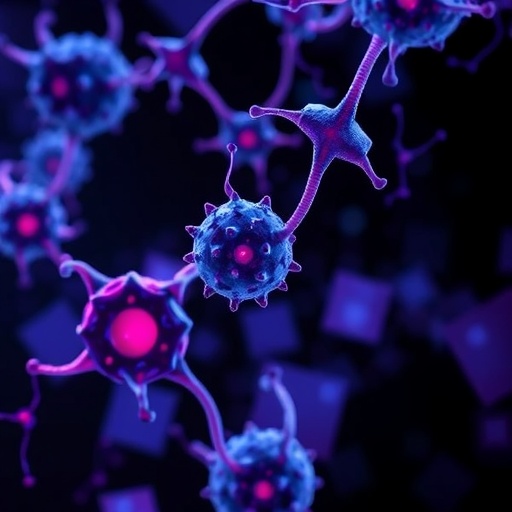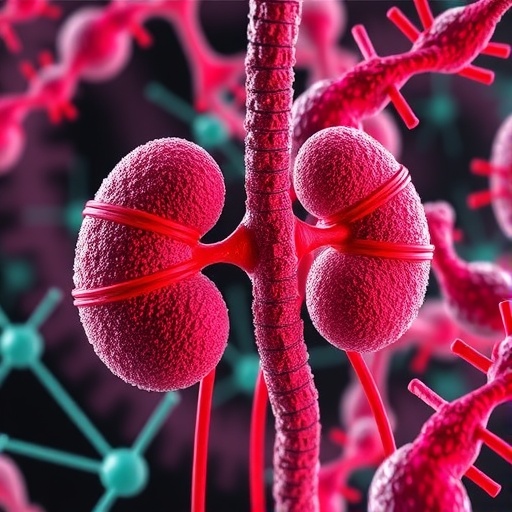In the intricate battle waged between viral pathogens and the human immune system, Epstein-Barr virus (EBV) stands out for its crafty ability to shape immune responses and impact cancer development. A groundbreaking study published in BMC Cancer sheds new light on the dysfunctional state of peripheral EBV antigen-specific T cells in patients suffering from EBV-positive diffuse large B-cell lymphoma (EBV+ DLBCL), a particularly aggressive form of lymphoma with a notoriously poor prognosis. This research provides a pivotal lens through which immunologists and oncologists can better understand the mechanisms behind immune evasion in EBV-associated malignancies and opens potential avenues for innovative immunotherapeutic interventions.
EBV is a ubiquitous herpesvirus known for establishing latent infections in B cells. While typically controlled by the immune system, in certain contexts—such as in EBV+ DLBCL—it contributes to oncogenesis and tumor progression. The ability of the virus to dampen anti-tumor immunity, particularly by modulating T cell function, is thought to be central to this process. To dissect this immune dysfunction, researchers embarked on a comprehensive investigation comparing immune profiles among patients with EBV+ DLBCL, EBV-negative DLBCL (EBV− DLBCL), and healthy controls.
One of the core findings from this study was the remarkable decrease in interferon-gamma (IFN-γ) secreting T cells following stimulation with EBV-derived peptides in EBV+ DLBCL patients compared to their EBV-negative counterparts. IFN-γ is a critical cytokine in antitumor immunity, orchestrating the activation of cytotoxic T cells and natural killer cells. The diminished IFN-γ response signals an impaired antiviral and antitumor T cell response, laying the foundation for viral persistence and lymphoma progression.
.adsslot_Gjuy1swo8B{ width:728px !important; height:90px !important; }
@media (max-width:1199px) { .adsslot_Gjuy1swo8B{ width:468px !important; height:60px !important; } }
@media (max-width:767px) { .adsslot_Gjuy1swo8B{ width:320px !important; height:50px !important; } }
ADVERTISEMENT
Delving deeper, flow cytometric analysis revealed significant alterations in the composition of T cell subsets in EBV+ patients. There was a marked reduction in total lymphocyte counts, with notable depletion of both CD8+ cytotoxic T lymphocytes and CD4+ helper T cells exhibiting central memory phenotypes. Central memory T cells are critical for long-lived immune memory and rapid recall responses; their diminishment suggests a compromised capacity to mount effective immune defenses upon antigen re-exposure.
Simultaneously, the study observed an increase in effector memory T cells within both CD4+ and CD8+ compartments. While effector memory T cells provide more immediate responses, their accumulation in chronic viral infections or cancer can reflect a skewed differentiation state, often accompanied by functional exhaustion. In the EBV+ lymphoma context, this shift hints at a chronic antigenic stimulation driving T cells towards a dysfunctional profile.
The hallmark of T cell exhaustion—characterized by upregulated inhibitory receptors—was strikingly evidenced in these patients. Elevated expression of Programmed cell death protein 1 (PD-1) on both CD4+ and CD8+ T cells was documented, signifying an exhausted immunophenotype. PD-1 is a co-inhibitory receptor that, when overexpressed, dampens T cell activation and effector function, enabling tumors and viruses to evade immune surveillance. This finding underscores why EBV+ DLBCL patients might not adequately control viral oncogenesis.
Furthermore, the research illuminated a reduction in the subpopulation of CD4+ T cells lacking both TIM-3 and CTLA-4 expression. These molecules are additional immune checkpoints associated with exhaustion and immune regulation, and their altered expression patterns further map the dysfunctional immune landscape in EBV+ lymphomas.
Senescence markers were also evaluated in T cell subsets, revealing a significant decline in CD28+KLRG1− and CD28+CD57−KLRG1− subsets among CD8+ T cells in EBV+ patients. The loss of CD28, a vital costimulatory molecule for T cell activation, alongside the upregulation of senescence-associated markers like KLRG1 and CD57, indicates an aged or terminally differentiated state of T cells. This senescent phenotype impairs proliferation and cytokine production, compounding the functional deficits observed.
Strikingly, when peripheral blood mononuclear cells were stimulated with PMA and brefeldin A to assess intrinsic IFN-γ production independent of antigen stimulation, CD8+ T cells from EBV+ patients still demonstrated reduced IFN-γ expression. This suggests an intrinsic impairment within cytotoxic T cells, beyond mere antigen-specific exhaustion, indicative of a pervasive immune dysfunction.
Taken together, these comprehensive immunophenotypic and functional analyses illuminate a compromised cellular immune milieu in EBV+ DLBCL patients. The skewing of T cell subsets away from naïve and central memory phenotypes towards exhausted, senescent, and dysfunctional states manifests as an impaired capacity to respond effectively to EBV antigens. This deficit likely contributes to viral persistence and unchecked tumor growth, underscoring the critical link between EBV-driven immune dysregulation and lymphoma pathogenesis.
Clinically, these findings have profound implications. They suggest that traditional therapeutic approaches targeting the tumor alone may be insufficient. Instead, revitalizing T cell function through checkpoint blockade therapies—for instance, anti-PD-1 or anti-CTLA-4 antibodies—could restore immune competence against EBV and improve patient outcomes. However, the presence of senescent T cells implies that combinatorial strategies addressing both exhaustion and senescence might be necessary.
Moreover, the reduction in critical co-stimulatory molecules such as CD28 in CD8+ populations indicates a potential challenge for adoptive T cell therapies or vaccines relying on these cells. Understanding the exact molecular mechanisms behind this loss could guide the engineering of more resilient T cell products capable of overcoming these inhibitory environments.
This study also provides a valuable framework for investigating other EBV-associated malignancies, such as nasopharyngeal carcinoma or Hodgkin lymphoma, where similar immune evasion mechanisms might be at play. Broadly, mapping the immune landscape with such granularity empowers the design of precision immunotherapies tailored to the unique immune contexts created by oncogenic viruses.
Furthermore, these insights into T cell dysfunction might inform diagnostic strategies, where immune profiling could serve as a biomarker to predict disease prognosis or to monitor therapeutic response. For patients with EBV+ DLBCL, tracking changes in T cell exhaustion and senescence markers could guide individualized treatment decisions.
From an immunological perspective, the study reaffirms the intricate balance between immune activation and regulation. Chronic viral infections like EBV exert ongoing antigenic pressure, driving T cells into states of exhaustion and senescence, which tumors exploit to evade clearance. Disrupting this balance restores immune surveillance but requires nuanced approaches that prevent hyperactivation and autoimmunity.
In conclusion, the dysfunction of peripheral EBV antigen-specific T cells in EBV+ diffuse large B-cell lymphoma represents a pivotal obstacle to effective immune responses against this formidable cancer. By elucidating the phenotypic and functional impairments—ranging from altered T cell subset distribution to elevated exhaustion and senescence markers—this research paves the way for novel therapeutic strategies aimed at reinvigorating the immune system. The fight against EBV-associated lymphomas may well hinge on overcoming these immunological barriers, transforming a dysfunctional foe into a powerful ally in cancer control.
Subject of Research: Dysfunction of peripheral EBV antigen-specific T cells in Epstein–Barr virus positive diffuse large B-cell lymphoma
Article Title: Peripheral EBV antigen-specific T cell is dysfunctional in Epstein–Barr virus positive diffuse large B-cell lymphoma
Article References:
Gao, L., Wang, L., Xue, C. et al. Peripheral EBV antigen-specific T cell is dysfunctional in Epstein–Barr virus positive diffuse large B-cell lymphoma. BMC Cancer 25, 1318 (2025). https://doi.org/10.1186/s12885-025-14723-7
Image Credits: Scienmag.com
DOI: https://doi.org/10.1186/s12885-025-14723-7
Tags: aggressive lymphoma prognosisB cell latent infectionsdysfunctional T cellsEBV-positive diffuse large B-cell lymphomaEpstein-Barr virus lymphomaImmune Evasion Mechanismsimmune profiles in lymphomaimmunotherapy for lymphomainterferon-gamma T cellsoncogenesis and tumor progressionT cell dysfunction in cancerviral impact on immune responses





